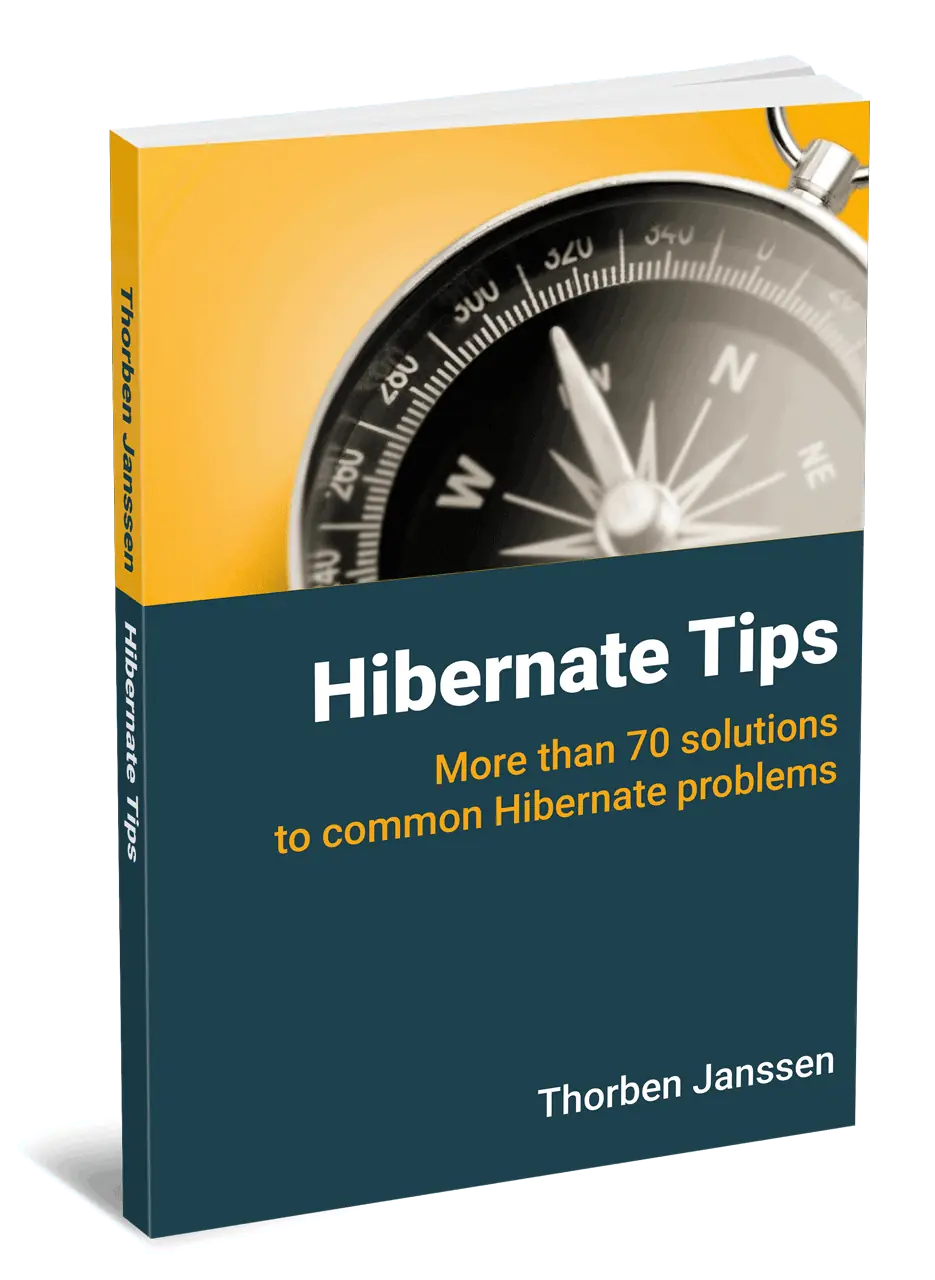JPA Tips: How to map a Duration attribute
Take your skills to the next level!
The Persistence Hub is the place to be for every Java developer. It gives you access to all my premium video courses, monthly Java Persistence News, monthly coding problems, and regular expert sessions.
Hibernate Tips is a series of posts in which I describe a quick and easy solution for common Hibernate questions. If you have a question for a future Hibernate Tip, please leave a comment below.
Question:
JPA 2.2 didn’t add support for java.time.Duration. How can I map an attribute of that type with JPA?
Solution:
Unfortunately, JPA 2.2 only supports some of the classes of the Date and Time API and java.time.Duration isn’t one of them. If you are limited to plain JPA, you need to implement a custom mapping for attributes of type Duration. As you will see, that is not as complicated as it might seem.
Hibernate makes it easy
But before we dive into the details, I want to show you a more comfortable approach. Since version 5, Hibernate supports java.time.Duration as a basic type. So, if you are allowed to use proprietary Hibernate features, you can use entity attributes of type Duration without any additional mapping annotations.
@Entity
public class OnlineCourse {
@Id
@GeneratedValue
private Long id;
private String title;
private Duration videoDuration;
...
}
JPA requires a little bit of work
If you don’t use Hibernate or if some internal regulations prevent you from using proprietary features, you can implement a custom mapping with a simple AttributeConverter. Within this converter, you need to map the unsupported Duration object to an object of a supported type.
You can, for example, convert the Duration object to a long which represents the number of nanoseconds of the duration. Just be aware that this limits your Duration to a little bit more than 292 years. That should be enough for most applications. If you need to store a longer duration, you will need to reduce the precision, e.g., persist the number of milliseconds.
The implementation of such a converter is relatively simple. You just need to implement the AttributeConverter<Duration, Long> interface and annotate the class with a @Converter annotation. You should set the autoApply attribute of the annotation to true. This tells your persistence provider to use the converter for all entity attributes of type java.time.Duration.
Here you can see an example of such an AttributeConverter. Within the convertToDatabaseColumn method, I call the toNanos method of the Duration object to convert it to long. And the convertToEntityAttribute method uses the of method with ChronoUnits.NANOS to implement the inverse conversion.
@Converter(autoApply = true)
public class DurationConverter implements AttributeConverter<Duration, Long> {
Logger log = Logger.getLogger(DurationConverter.class.getSimpleName());
@Override
public Long convertToDatabaseColumn(Duration attribute) {
log.info("Convert to Long");
return attribute.toNanos();
}
@Override
public Duration convertToEntityAttribute(Long duration) {
log.info("Convert to Duration");
return Duration.of(duration, ChronoUnit.NANOS);
}
}
That’s all you need to do. You can now use the OnlineCourse entity which I showed you at the beginning of this post. Your persistence provider applies the DurationConverter automatically so that you don’t need to adapt your entity mapping.
// Transaction 1: Persist a new OnlineCourse entity
EntityManager em = emf.createEntityManager();
em.getTransaction().begin();
OnlineCourse c = new OnlineCourse();
c.setTitle("Hibernate Performance Tuning Online Training");
c.setVideoDuration(Duration.parse("PT5H55M"));
em.persist(c);
em.getTransaction().commit();
em.close();
// Transaction 2: Read an OnlineCourse entity
em = emf.createEntityManager();
em.getTransaction().begin();
em.find(OnlineCourse.class, c.getId());
log.info("The "+c.getTitle()+" contains "+c.getVideoDuration().toMinutes()/60+" hours and "+c.getVideoDuration().toMinutes()%60+" minutes of video");
em.getTransaction().commit();
em.close();
As you can see in the log output, the DurationConverter gets called twice to map the videoDuration attribute:
- When the entity gets persisted, the convertToDatabaseColumn method gets called to map the Duration to a Long object
- When the entity gets read from the database, the convertToEntityAttribute method gets called to map the Long to a Duration object
17:47:15,197 DEBUG [org.hibernate.SQL] - select nextval ('hibernate_sequence')
17:47:15,241 DEBUG [org.hibernate.SQL] - insert into OnlineCourse (title, version, videoDuration, id) values (?, ?, ?, ?)
17:47:15,246 INFO [DurationConverter] - Convert to Long
17:47:15,276 DEBUG [org.hibernate.SQL] - select onlinecour0_.id as id1_0_0_, onlinecour0_.title as title2_0_0_, onlinecour0_.version as version3_0_0_, onlinecour0_.videoDuration as videoDur4_0_0_ from OnlineCourse onlinecour0_ where onlinecour0_.id=?
17:47:15,290 INFO [DurationConverter] - Convert to Duration
17:47:15,294 INFO [org.thoughts.on.java.model.TestAttributeConverter] - The Hibernate Performance Tuning Online Training contains 5 hours and 55 minutes of video
Learn more:
The AttributeConverter is a powerful and easy to use feature. You can use it to:
Hibernate Tips Book

Get more recipes like this one in my new book Hibernate Tips: More than 70 solutions to common Hibernate problems.
It gives you more than 70 ready-to-use recipes for topics like basic and advanced mappings, logging, Java 8 support, caching, and statically and dynamically defined queries.


Thank you thoughts-on-java for giving me wonderful information about map duration